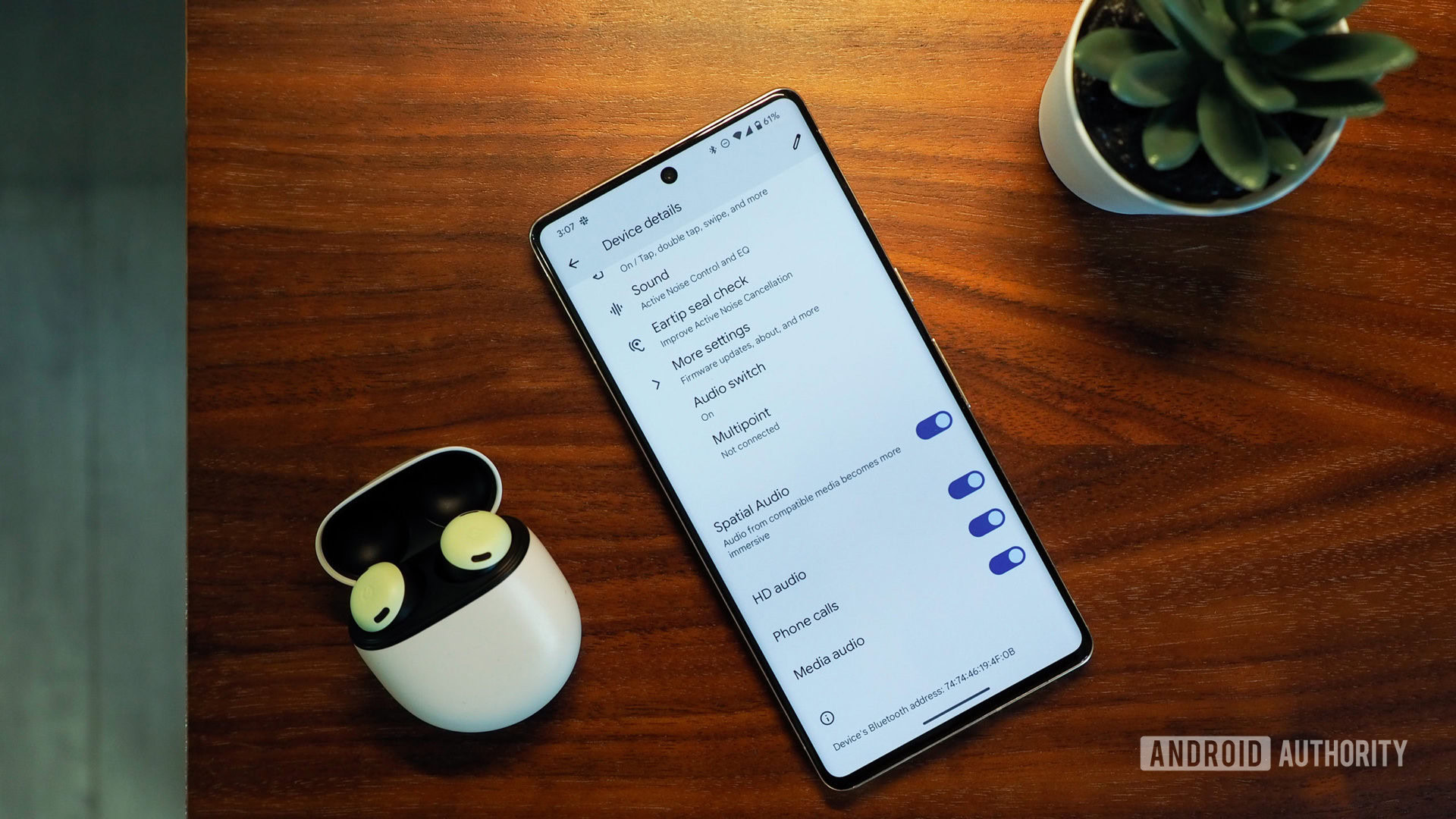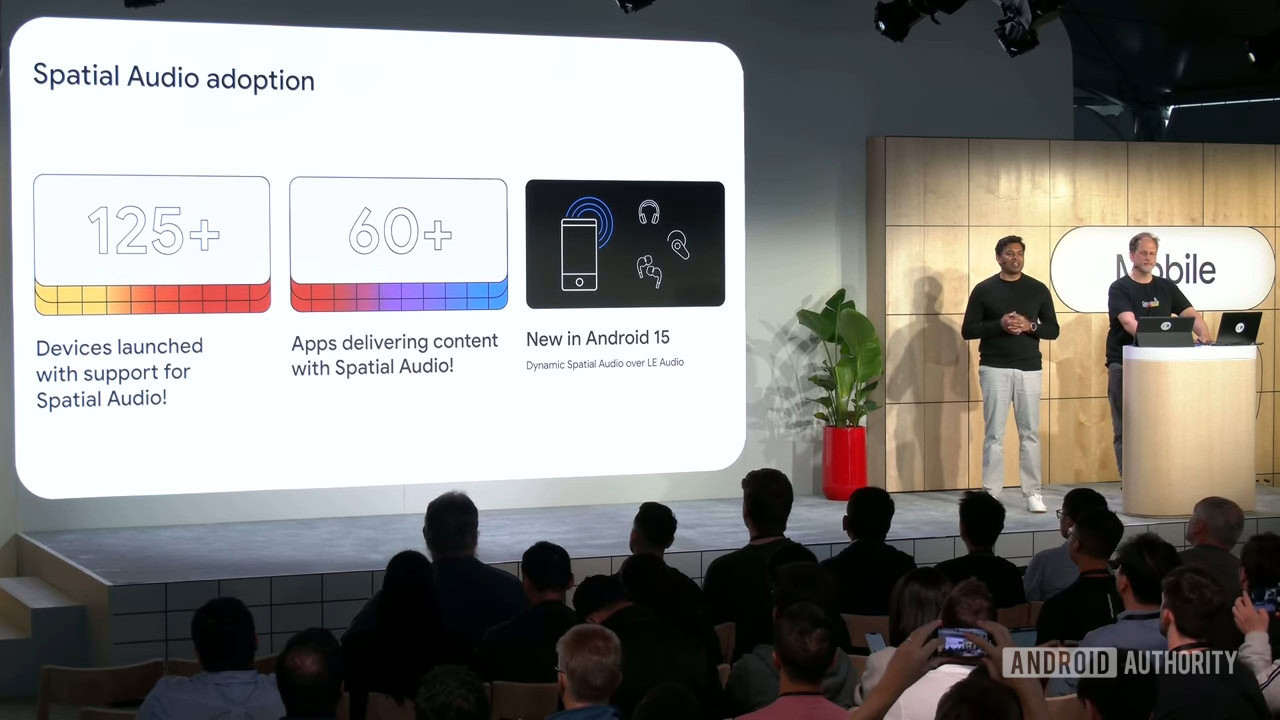Affiliate links on Android Authority may earn us a commission. Learn more.
Spatial audio will be even more immersive in Android 15
Published onJune 3, 2024

- Google is enabling support for dynamic spatial audio over Bluetooth LE Audio in Android 15.
- Dynamic spatial audio allows for the direction of sound to change based on the listener’s head movements.
- Head-tracked spatial audio is already supported over Bluetooth Classic Audio, but expanding support to LE Audio will make for an even more immersive experience.
Watching a movie or TV show on most Android phones delivers a far less immersive audio experience than most cinemas. That’s because most mobile devices don’t have enough speakers arranged in the right locations to deliver a true surround sound experience. The same goes for most headphones and wireless earbuds, too. Fortunately, there’s a trick that can be used to create a more immersive listening experience when using compatible audio products like the Pixel Buds Pro. It’s called spatial audio, and it’s set to get even better in the upcoming Android 15 update.
Although the audio in many movies and TV shows is recorded with multiple channels, only two stereo channels (left and right) are played back with most headphones and wireless earbuds. This is why most audio from your phone sounds like it’s coming from right in front of you. To make the audio from your phone sound like it’s coming from all around you, your phone would normally need to have multiple speakers surrounding you, which is physically impossible. This is where spatial audio comes in.
Spatial audio is a clever software trick that processes sound to create the illusion that it’s coming from different directions. For example, if you’re watching a nature documentary and there’s a scene showing a whale swimming through the ocean, you might hear its vocalizations intensify as it comes in and then fade as it swims away. Spatial audio offers a richer, more immersive mobile listening experience, especially when watching a TV show or movie, which is why many streaming services have been pushing it.
To support spatial audio in Android, Google added APIs in Android 13 that let app developers discover whether the phone is set up to support the feature. If it does, then so long as the app tries to play content that can be spatialized (usually audio with 5.1 or more channels), the platform will output spatialized audio. If it doesn’t, it’s because the device maker didn’t provide a spatializer audio effect that the platform can use to spatialize audio.
On the other hand, all wired and wireless audio devices can support spatial audio, at least the static kind. That’s because, with static spatial audio, sounds are anchored to the user and move with you. This means that a sound coming from the left will always come from the left, no matter how you move your head. With dynamic spatial audio, though, sounds are anchored to the environment and don’t move with you. This means that a sound coming from your left will sound like it’s coming from right in front of you if you turn your head to the left.
Source: Google.
Since dynamic spatial audio requires tracking the position of your head, your connected headset needs to have head-tracking sensors. Plus, your phone’s device maker needs to configure the phone to use a very low-latency Bluetooth audio codec when dynamic spatial audio is enabled. However, because the headset needs to process the audio very quickly while also tracking the user’s head movements, dynamic spatial audio can be very power-intensive.
One way to reduce the power draw of dynamic spatial audio is to switch from using Bluetooth Classic Audio to Bluetooth LE Audio. Bluetooth LE Audio transmits audio over Bluetooth Low Energy, which consumes less power. Currently, Android doesn’t support dynamic spatial audio over Bluetooth LE Audio, but that’s set to change in Android 15.
At last month’s Google I/O developer conference, Google announced that they were enabling support for dynamic spatial audio over LE Audio in Android 15.

Besides opening up dynamic spatial audio to the growing number of LE Audio-compatible products, this change is also beneficial because LE Audio “provides lower head-tracking latency and better bandwidth utilization for an even more immersive experience,” according to Karthic Veera, Product Manager for Android Media and Camera.
Thus, we can expect dynamic spatial audio to be even more immersive in Android 15 when device makers switch to using Bluetooth LE Audio, as they won’t have to compromise as much on latency and audio quality to save battery life.